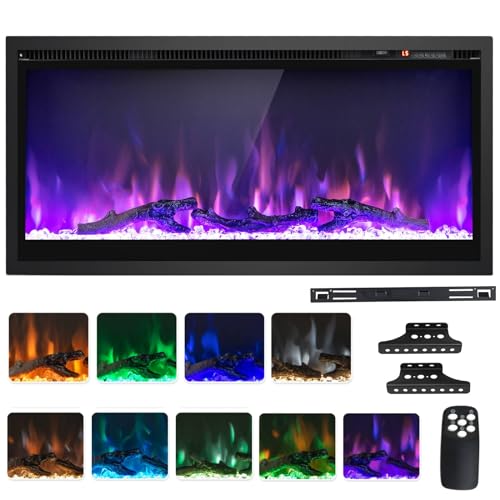The No. 1 Question Anyone Working In Wall-Mounted Fireplace Should Be Able Answer
The Elegance and Efficiency of Wall-Mounted Fireplaces
In the world of home decoration and heating services, wall-mounted fireplaces have actually gotten significant popularity. These innovative components combine visual appeal with functionality, making them a preferred choice for many house owners. This post dives into the various elements of wall-mounted fireplaces, exploring their advantages, types, installation procedures, and maintenance pointers.
What is a Wall-Mounted Fireplace?
A wall-mounted fireplace, typically referred to as a wall-mounted hearth, is a contemporary version of traditional fireplaces that is fixed to the wall, developing an elegant and space-efficient design. Unlike traditional fireplaces that need a substantial footprint and complex venting systems, wall-mounted fireplaces offer versatility and design without occupying much flooring area.
Benefits of Wall-Mounted Fireplaces
Wall-mounted fireplaces included a myriad of benefits that boost both the visual and practical aspects of a home. Here are a few of the crucial benefits:
- Space-Saving Design: Perfect for smaller living locations where floor space is restricted.
- Versatile Aesthetics: Available in a variety of designs, materials, and surfaces, permitting combination into any decoration design.
- Easy Installation: Typically simpler to set up than traditional fireplaces, numerous models do not need substantial construction work.
- Eco-friendly Options: Many wall-mounted fireplaces utilize biofuels or electrical power, lowering their carbon footprint compared to wood-burning designs.
- Heat Efficiency: Modern innovation permits these fireplaces to offer effective heating without the heat loss frequently connected with standard systems.
Types of Wall-Mounted Fireplaces
Wall-mounted fireplaces can be found in numerous designs and fuel types, catering to varied preferences and needs. They can be categorized normally as follows:
Type
Description
Fuel Source
Electric Fireplaces
Mimic the appearance of real flames with LED lights and can supply heat.
Electricity
Bioethanol Fireplaces
Usage bioethanol as fuel, producing genuine flames without the need for a chimney.
Bioethanol
Gel Fuel Fireplaces
Use gel fuel canisters that produce genuine flames, appropriate for indoor and outside use.
Gel fuel canisters
Wood-Burning Fireplaces
Supply genuine flames and warmth but require a chimney and more area.
Wood
Gas Fireplaces
Use gas or gas; typically featured a remote for easy control.
Natural gas/Propane
Setup Process
Installing a wall-mounted fireplace can be fairly straightforward, though particular steps might differ based upon the type selected. Here's a basic guide for setup:
- Choosing the Right Location: Select a wall that has access to necessary energies (electrical power or gas lines) and enables visibility and enjoyment of the flames.
- Check for Clearances: Ensure the area satisfies safety clearance requirements for heat sources.
- Prepare the Wall: Mark where the fireplace will be mounted. Ensure the wall is steady enough to support the unit's weight.
- Electrical wiring (if necessary): If the fireplace is electric or gas, guarantee all wiring or gas lines are set up by a licensed specialist.
- Mounting the Fireplace: Follow the maker's directions to firmly connect the fireplace to the wall.
- Last Touches: Connect power or gas and test the fireplace to guarantee it operates correctly.
Upkeep Tips for Wall-Mounted Fireplaces
To ensure durability and effectiveness, routine upkeep of wall-mounted fireplaces is important. Here are some maintenance tips:
- Regular Cleaning: Dust and tidy the system according to the producer's guidelines to keep the glass and surface areas clear.
- Inspect Fuel Supplies: Monitor and change fuel sources (bioethanol, gas containers) as needed.
- Inspect for Damage: Regularly examine for any indications of wear or damage to parts, especially in gas or wood-burning models.
- Professional Servicing: Have the fireplace checked and serviced by experts, especially for gas designs, at least once a year.
Typical FAQs
1. Are wall-mounted fireplaces safe?Yes, wall-mounted fireplaces are created with safety in mind. Electric and bioethanol fireplaces are usually more secure than traditional wood-burning designs, which can produce damaging emissions. 2. Do I need a chimney for a wall-mounted fireplace?Most wall-mountedfireplaces do not require a chimney, especially electric and bioethanol models. However, gas and wood-burning models may require correct venting. 3. Can I install a wall-mounted fireplace myself?While many installations can be finished by a DIY enthusiast, it's advised**to speak with professionals, particularly for gas or electric units that require precise circuitry or plumbing. 4. How much heat do wall-mounted fireplaces provide?The heating capability varies by design and type. Electric units can generate approximately 5,000 BTUs, while bioethanol systems can provide substantial heat also, depending on the size and output specs. 5. What is the life expectancy of a wall-mounted fireplace?With regular maintenance, wall-mounted fireplaces can last for several years, typically upwards of 10 to 15 years, depending on the type and use. Wall-mounted fireplaces not only improve the visual appeal of any space however also provide effective heating services for contemporary homes. With you can try here and styles available, property owners can discover the ideal suitable for their requirements and choices. Correct setup and upkeep
will make sure these stunning fixtures work as pleasurable and safe centerpieces in living spaces for years to come.  ******
******